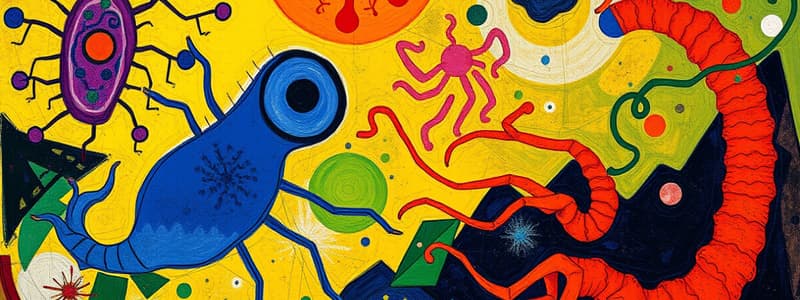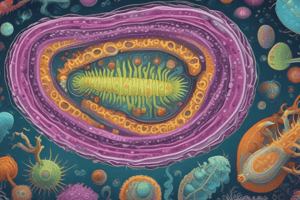Podcast
Questions and Answers
Parasites having both male and female reproductive organs are known as ____.
Parasites having both male and female reproductive organs are known as ____.
- Accidental parasites
- Hermaphrodites (correct)
- Schizonts
- Obligate parasites
All protists:
All protists:
- Have cell walls
- Are parasites
- Have a true nucleus (correct)
- Are photosynthetic
Many protists have shells of calcium carbonate called ____.
Many protists have shells of calcium carbonate called ____.
- Plastrons
- Carapaces
- Exoskeletons
- Tests (correct)
Protists may be described according to whether they resemble organisms in each of the following kingdoms except:
Protists may be described according to whether they resemble organisms in each of the following kingdoms except:
Euglenoids contain a stigma, the purpose of which is to:
Euglenoids contain a stigma, the purpose of which is to:
Diatoms possess:
Diatoms possess:
Which of the following is not an example of a plantlike protist?
Which of the following is not an example of a plantlike protist?
Animal-like protists include _____.
Animal-like protists include _____.
Water molds and slime molds have characteristics typical of _____.
Water molds and slime molds have characteristics typical of _____.
Organisms that obtain nutrients from decaying matter are called _____.
Organisms that obtain nutrients from decaying matter are called _____.
Which of the following organisms is a saprophyte?
Which of the following organisms is a saprophyte?
Protozoa are always:
Protozoa are always:
Protozoa that move using flagella are members of the ____.
Protozoa that move using flagella are members of the ____.
Protozoans found in the human intestinal tract would most likely be ____.
Protozoans found in the human intestinal tract would most likely be ____.
The only non-motile group of protozoans is the ____.
The only non-motile group of protozoans is the ____.
Malaria is a result of infection by a/an ____.
Malaria is a result of infection by a/an ____.
The proper order of development of Plasmodium from the time of infection to the parasitization of red blood cells is:
The proper order of development of Plasmodium from the time of infection to the parasitization of red blood cells is:
The largest group of protozoa is the ____.
The largest group of protozoa is the ____.
Which of the following statements about protists is true?
Which of the following statements about protists is true?
Mycology is defined as the study of ____.
Mycology is defined as the study of ____.
Cells walls in fungi are often made of ____.
Cells walls in fungi are often made of ____.
Fungal hyphae are sometimes separated into smaller compartments by cross walls called ____.
Fungal hyphae are sometimes separated into smaller compartments by cross walls called ____.
Fungi are never ____.
Fungi are never ____.
Fungi are classified according to the ____.
Fungi are classified according to the ____.
Fungi can be differentiated from plants by the fact that:
Fungi can be differentiated from plants by the fact that:
Bread molds are members of the phylum ____.
Bread molds are members of the phylum ____.
Flashcards are hidden until you start studying
Study Notes
Parasites and Protists
- Hermaphrodites have both male and female reproductive organs.
- All protists possess a true nucleus, distinguishing them from prokaryotic organisms.
- Some protists have shells made of calcium carbonate, referred to as tests.
- Protists are classified based on resemblance to organisms in the kingdoms of fungi, animals, and plants, but not bacteria.
Euglenoids and Diatoms
- Euglenoids possess a stigma that helps them move toward light, aiding in photosynthesis.
- Diatoms feature photosynthetic pigments, an outer silicate layer, and are recognized for their abrasive properties.
Classification of Protists
- Examples of plant-like protists include Euglenoids, Diatoms, and Dinoflagellates; Amebozoans are not categorized as such.
- Animal-like protists are represented by apicomplexans, which are significant in various ecological roles.
- Water molds and slime molds share characteristics typical of fungi and animals.
Nutritional Strategies
- Saprophytes absorb nutrients from decaying matter and are classified as heterotrophs.
- Protozoa are always heterotrophic, feeding on organic matter.
Protozoan Movement and Types
- Mastigophorans are protozoa that utilize flagella for movement.
- Amebozoans, commonly found in human intestines, are known for their ameba-like movement.
- Apicomplexans are a non-motile protozoan group, including the pathogen that causes malaria.
Malaria Life Cycle
- The life cycle of Plasmodium involves stages: sporozoite → merozoite → trophozoite.
Fungi Characteristics
- Mycology is the study of fungi, characterized by cell walls made of chitin.
- Fungal hyphae may have cross walls, known as septa, separating them into compartments.
- Fungi are heterotrophs, but not obligate parasites; they can be saprophytes or facultative parasites.
Fungal Classification
- Fungi are classified based on the nature of their sexual cycle.
- Bread molds belong to the phylum Zygomycota.
- Fungi differ from plants primarily because they cannot photosynthesize, while plants can.
General Characteristics
- The largest protozoan group is the ciliates, known for their motility.
- All protists are eukaryotic, contrasting with prokaryotic microorganisms like bacteria.
Studying That Suits You
Use AI to generate personalized quizzes and flashcards to suit your learning preferences.




